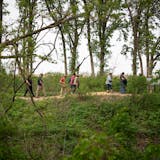There was no doctor in the house when Sam Talbot arrived at his clinic for a recent physical, but then that was the plan.
The 30-year-old ecology researcher chose for his primary care one of the state's first clinics staffed solely by nurse practitioners — who have the training beyond registered nurses to diagnose patients, order tests, prescribe drugs, stitch wounds, and perform most tasks traditionally ascribed to family doctors.
"I don't particularly like going to the doctor," Talbot said. "Nurse practitioners feel a little bit less threatening."
Nurse practitioners, or NPs, are becoming vital to Minnesota's medical system, which is seeing the demands of an aging patient population outpace the existing supply of doctors. Since the state Legislature in 2014 enacted the first state licensing standards for advanced practice registered nurses, the number of licensed NPs has increased by more than a third from 3,864 to 5,619.
The Minnesota Department of Employment and Economic Development lists nurse practitioner as the seventh fastest growing profession in the state — based on a 10-year projection that the supply of NPs will increase 26 percent.
"We really haven't seen an initiative that has caught on this broadly in the nursing profession, probably ever," said Connie Delaney, dean of the University of Minnesota's School of Nursing, which based on full-time student enrollment has the nation's largest doctoral training program for nurse practitioners.
"This is all about continuing to build the workforce," she said. "In about another dozen years, 20 percent of Minnesotans are going to be over 65. That's scary."
Clinic groups have incentives to advance the NP trend. State economic data show that nurse practitioners make $108,000 per year on average, while family and general practitioners make $190,000 — a 76 percent difference. But insurance companies typically pay only 15 percent less to clinics when basic care is provided by NPs instead of doctors.
![Three weeks ago, Octavio Rodriguez switched from making transmission parts to casting parts for hospital bed brake assemblies at Twin City Die Castings. ] GLEN STUBBE • glen.stubbe@startribune.com Thursday, April 9, 2020 How employee-owned Twin City Die Casting, which just laid off 40 production workers of its 250 employees in what was supposed to be a good year, is trying to accelerate its pivot to growing medical parts business for ventilators, hospital beds, etc as it copes with instan](https://arc.stimg.co/startribunemedia/WNZYKGTZ5IYMUCO3KI5TR3N7WI.jpg?&w=80&ar=1:1&fit=crop)
djoles@startribune.com As boaters flock to Minnesota lakes and rivers this holiday weekend for the unofficial kick-off to the boating season, they'll face more inspections in and out of the water as local cities and counties ramp up their work to stop the spread of invasive species. Across the metro, more boat accesses will be staffed by watercraft inspectors thanks to $10 million funneled to county government programs this year, up from $4.5 million the state allocated last year. ORG XMIT: MIN1505222156290209 ORG XMIT: MIN1506021218440580](https://arc.stimg.co/startribunemedia/34QSKO44B2XKVNUZCO5SLJQSLY.jpg?&w=80&ar=1:1&fit=crop)

